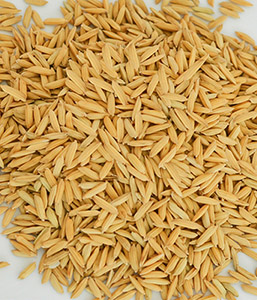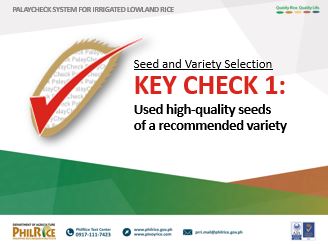Variety and Seed Selection
KEY CHECK 1:
Used high quality-seeds
of a recommended variety.
High-quality seeds are relatively pure, have fewer weed seeds, free from visible seed-borne diseases, full and uniform in size, and have at least 85% germination rate.
As crops from high-quality seeds grow, mature, and ripen uniformly, harvesting activities become more efficient. All of these can contribute to an increase in yield of 10% or more.
Recommended varieties are adapted to local conditions. They are resistant to biotic and abiotic stresses (e.g. prevalent pests and diseases, drought) in the area, have produced relatively stable and high yields, and are preferred by farmers and local consumers.
ASSESSMENT OF KEY CHECK
- Seeds are certified by the Bureau of Plant Industry – National Seed Quality Control Services (BPI-NSQCS). If there are no accredited seed growers in the locality, high-quality seeds are accessed from reliable sources or own-produced.
- The variety suits the environment, addresses a prevailing local field problem, or has performed well in at least two seasons of adaptability trials.
RECOMMENDATIONS TO ACHIEVE KEY CHECK
1. Source seeds preferably from accredited seed growers. Check if the attached NSQCS tag is valid.
- If seeds are old stock or carry-over from the previous season, these should have passed the germination re-test before sowing. If there are no accredited seed growers:
- source seeds from reliable farmers in the area (i.e. from farms that have uniform crop growth)
- produce own high-quality seeds following proper procedures, particularly in roguing or removing off-types
- ensure that farmer-produced seeds have passed a germination re-test to determine their quality, which may be done by the farmer or NSQCS
2. Choose a variety that:
a. suits the environment (irrigated or rainfed) or planting season (DS or WS). In rainfed areas, it is best to prioritize varieties intended for the rainfed environment. During the wet season, beware of prevalent pests in the area and consider the shattering and lodging characteristics of a variety.
b. addresses a prevailing local field problem. In areas that are usually affected by destructive typhoons, drought, or floods, especially during the WS, use a variety with suitable maturity that can escape potential abiotic stresses. Consider also regionally recommended varieties as these are most likely adapted in the locality.
Caption for NSIC Rc222 and PSB Rc10: NSIC Rc222 is recommended for DS and WS in Central Luzon. PSB Rc10 is an early-maturing variety (106 days) that can fit the crop calendar before the typhoon months. (Tip: Use the Binhing Palay App mobile application to search for registered rice varieties and their characteristics. Download the app for free at Google Playstore.)
To know the characteristics of a variety, text Rc and # of the variety or its common name, Example: Rc222 and send to 0917 111 7423. Note: 1 text/variety to received instant reply anytime.
c. has performed well in at least two seasons of adaptability trials made by PhilRice or local DA office.
d. has high market demand.
MATERIALS
Handouts
Audio Clips











